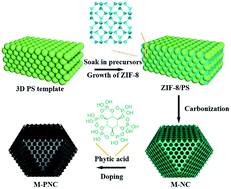Highly ordered macroporous dual-element-doped carbon from metal–organic frameworks for catalyzing oxygen reduction†
Abstract
Multiple heteroatom-doped carbons with 3D ordered macro/meso-microporous structures have not been realized by simple carbonization of metal–organic frameworks (MOFs). Herein, ordered macroporous phosphorus- and nitrogen-doped carbon (M-PNC) is prepared successfully by carbonization of double-solvent-induced MOF/polystyrene sphere (PS) precursors accompanied with spontaneous removal of the PS template, followed by post-doping. M-PNC shows a high specific surface area of 837 m2 g−1, nitrogen doping of 3.17 at%, and phosphorus doping of 1.12 at%. Thanks to the hierarchical structure, high specific surface area, and multiple heteroatom-doping, M-PNC exhibits unusual catalytic activity as an electrocatalyst for the oxygen reduction reaction. Computational calculation reveals that the P![[double bond, length as m-dash]](https://www.rsc.org/images/entities/char_e001.gif) O group helps stabilize the adsorption of intermediates, and the position of P
O group helps stabilize the adsorption of intermediates, and the position of P![[double bond, length as m-dash]](https://www.rsc.org/images/entities/char_e001.gif) O relative to graphitic N significantly improves the activity of the adjacent carbons for electrocatalysis.
O relative to graphitic N significantly improves the activity of the adjacent carbons for electrocatalysis.



 Please wait while we load your content...
Please wait while we load your content...